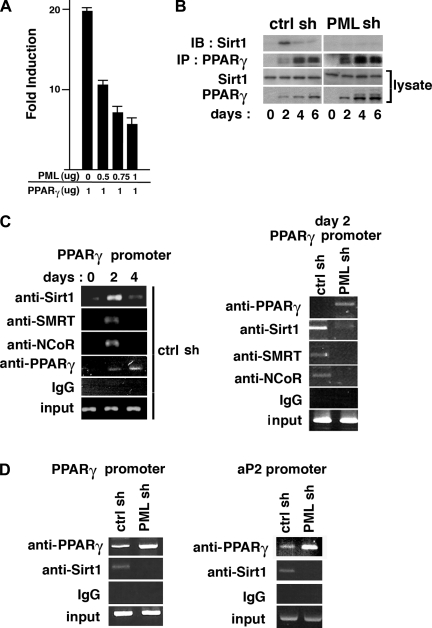Fig. 4.
PML loss attenuates Sirt1-PPARγ interaction and inhibits Sirt1-nuclear corepressor(NCoR)-silencing mediator for retinoic and thyroid hormone receptor (SMRT) recruitment to the pparγ promoter during adipogenesis in 3T3-L1 cells. A: pGL3-pparγ-luc reporter plasmid was cotransfected into 293T cells with expression vectors for human PML4 and PPARγ together with renilla luciferase vector. Results are expressed as firefly luciferase activity normalized to renilla luciferase activity. B: coimmunoprecipitation of Sirt1 with PPARγ. Cell lysates of ctrl shRNA and PML shRNA-3T3-L1 cells were obtained during 0–6 days of adipogenesis and subjected to immunoprecipitation using anti-PPARγ (Santa Cruz Biotechnology) antibody. The immunoprecipitated complex was immunoblotted with anti-Sirt1 (Upstate Biotechnology) antibody. C, left: chromatin immunoprecipitation (ChIP) analysis on the pparγ promoter in ctrl shRNA 3T3-L1 cells using IgG and antibodies against Sirt1 (Upstate Biotechnology), SMRT (Santa Cruz Biotechnology), NCoR (Santa Cruz Biotechnology) and PPARγ (H-100; Santa Cruz Biotechnology) at indicated days after adipogenic induction. C, right: ChIP analyses on the pparγ promoter in ctrl shRNA and PML shRNA 3T3-L1 cells on day 2 after adipogenic induction. Twenty-five to 35 cycles of PCR reaction were performed. D: ChIP analysis on the pparγ or aP2 promoter. The chromatin-associated DNA samples were obtained in PML shRNA and ctrl shRNA cells on day 6 after differentiation and immunoprecipitated with IgG or antibodies against Sirt1 and PPARγ.

